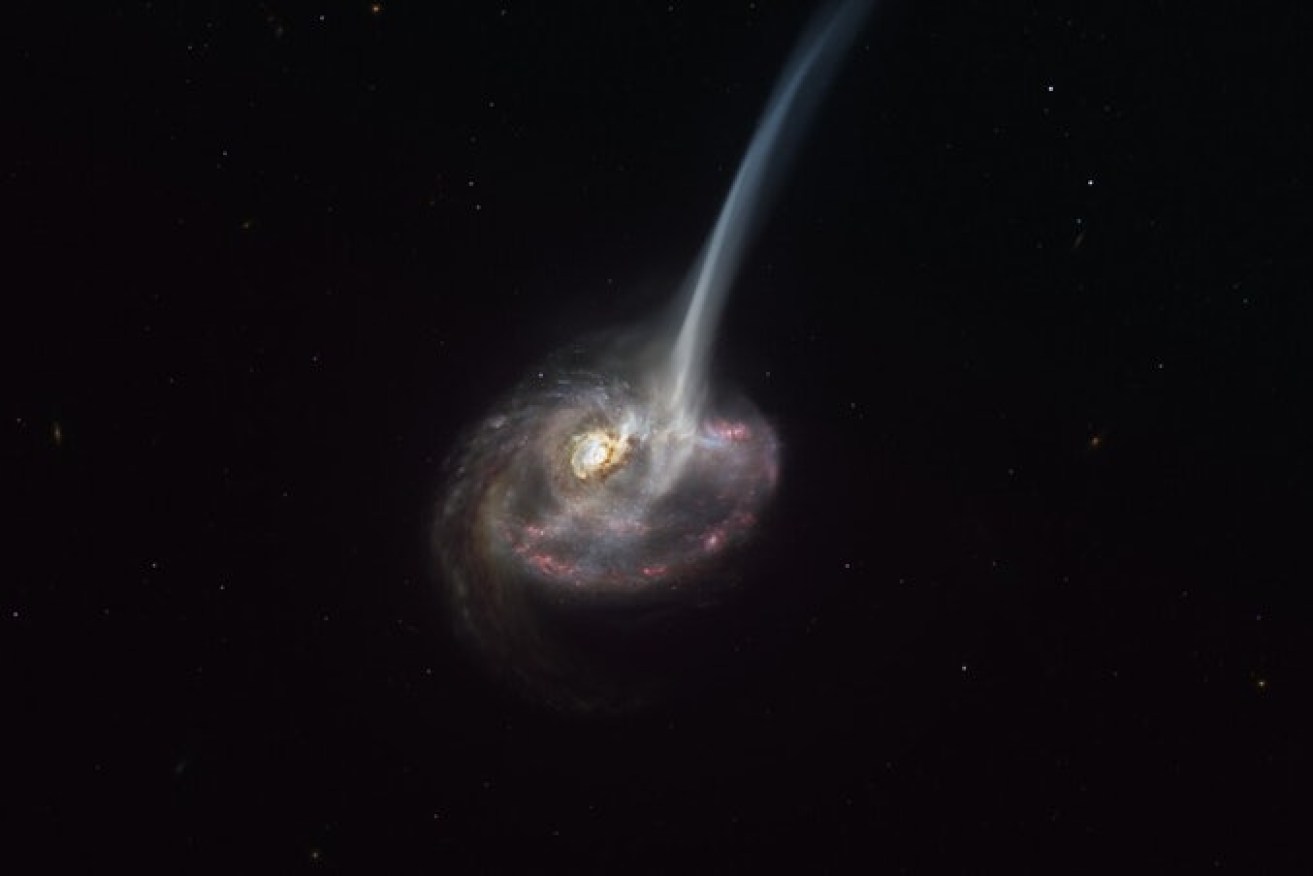From record-breaking comets to galaxies bleeding to death: This year’s best stories from space


For the first time, astronomers witnessed the death of a galaxy. One day the Milky Way will likewise run out of gas. Image: ESO
Space stories in 2021 seemed to be dominated by people and projects that sought to commercialise, colonise or otherwise investigate our corner of the universe.
The United Arab Emirates became the first Arab country to reach Mars with its orbital probe named Hope. Congratulations!
China and the US managed to land their rovers on the red planet and haven’t yet collided with one another in their search for life. Hooray!
The world’s richest man, Jeff Bezos, went into sub-orbital space. As did Richard Branson and his groovy beard.
The big-money men were ridiculed for what was perceived as hubristic displays of ego. Is there any other kind?

Captain Kirk went into space for real.
People were so annoyed with Mr Bezos that they launched a petition on Change.org to deny Mr Bezos re-entry to Earth.
Nearly 200,000 people signed it, but Mr Bezos came home anyway.
Still, that might be one small signature from man, but one giant ‘up yours’ from mankind. Woo hoo!
More importantly, and somehow heart-warmingly, Captain Kirk (William Shatner) finally touched the face of space in a pair of sensible trousers. Well done, sir!
Some missions of note
On Christmas morning, NASA launched the $US10 billion ($13.8 billion) James Webb Space Telescope with the humble mission of seeking out the birth of the universe, just about.
One of the most beautiful things about looking at stars is you’re actually seeing ancient history.

NASA’s James Webb Space Telescope. Image: NASA
The mission, as lyrically described by The New York Times, is to find the earliest, most distant stars and galaxies, which appeared 13.7 billion years ago, “burning their way out of a fog leftover from the Big Bang” (which occurred 13.8 billion years ago).
This year saw NASA take on a new role.
Until 2021, the space agency’s mission was all about exploration. Now it’s moved into defending the planet from wayward life-killing asteroids.

How the spacecraft will crash into an asteroid. Image: NASA
In November, the Double Asteroid Redirection Test (DART) mission was launched.
The idea is taken straight from Hollywood: Crash a spacecraft into an asteroid in a bid to smash it off course.
The plan is to hit the target asteroid, known as Dimorphos, at 24,140km/h as it orbits a larger asteroid Didymos.
Read more here.
Death of a galaxy

The galaxy is losing 10,000 suns per year. Image: ESO
Astronomers have seen, apparently for the first time, a galaxy bleeding to death – after colliding and merging with another galaxy.
The scientists, from the Centre for Extragalactic Astronomy at Durham University, detected a galaxy called ID2299 that is ejecting nearly half of its star-forming gas.
The galaxy is losing the equivalent of 10,000 suns per year in gas, removing 46 per cent of the total cold gas the galaxy contains.
Because the galaxy is also forming stars very rapidly, hundreds of times faster than our Milky Way, the gas that remains will be quickly consumed.
At the current rate, ID2299 will shut down in just a few tens of millions of years.
This is much faster than the typical duration of star formation episodes in galaxies, which is a few billion years.
Read more here.
Earth is losing its shine

A space-station image shows Earthshine on the Moon. Photo: NASA
Attention aliens from outer space: If you think the Earth is looking less shiny than it was 20 years ago, well, your goggle eyes aren’t deceiving you.
Earth-bound scientists are equally surprised at the extent to which our planet is reflecting less light.
A reduction in the amount of low-lying reflective clouds over the warming ocean is apparently to blame.
Shorter version: Climate change.
According to a statement from the American Geophysical Union (AGU), the Earth is now reflecting “about half a watt less light per square metre than it was 20 years ago, with most of the drop occurring in the last three years of Earthshine data”.
Read more here.
Biggest comet, like, ever

The giant comet last visited our inner solar system three million years ago. Image: NOIRlab
US researchers have discovered the biggest and perhaps weirdest comet ever detected, and it’s headed into our inner solar system for the first time in three million years.
Most comets have a diameter of less than 10 kilometres.
But the monster comet discovered in June is estimated to be 100 to 200 kilometres across, and about 1000 times bigger than a typical comet.
The huge size is a rough estimate based on how much sunlight the comet reflects. But just about everything about it is massive in scale.
The comet’s inward journey began six trillion kilometres away – 40,000 times farther than the distance between the Sun and the Earth.
Comet Bernardinelli-Bernstein – named after the University of Pennsylvania scientists who discovered it – will arrive at its closest point to the Sun in 2031, known as the perihelion.
But there’s no need to fret about potential oblivion – the comet is predicted to come no closer than Saturn, which is about 1.5 billion kilometres away.
Read more here.

Comet Leonard made pretty by an aurora. Image: Origin Space
Elsewhere, a small satellite belonging to Chinese space resources company Origin Space took this pretty image of Comet Leonard as it made its closest approach to Earth on December 12.
The comet, after making its closest pass at the Sun on January 3, will vanish from view for 80,000 years.
According to space.com, the satellite-telescope that caught the image, Yangwang 1, was launched earlier this year.
Its mission is to observe the universe around our planet in visible and ultraviolet light in the search for near-Earth asteroids that could potentially be mined for resources.
Einstein ring: A cosmic bull’s eye
In September, NASA published an image from the Hubble telescope of one of the largest and most complete Einstein rings ever seen.
An Einstein ring is a bull’s eye pattern created as the light from a galaxy far away is distorted into a circular shape by the gravity of a giant elliptical galaxy.
This phenomenon is called gravitational lensing and was first predicted by Albert Einstein almost a century ago.
Gravitational lensing occurs when the gravitational field from a massive object warps space and deflects light from a distant object behind it.
Einstein rings are the most elegant manifestation of the lensing phenomenon. They are produced when two galaxies are almost perfectly aligned, one behind the other.
Live fast, die young: The James Dean of stars
In celebration of the 31st anniversary of the launching of NASA’s Hubble Space Telescope, astronomers aimed the grand observatory at a rare and brilliant “celebrity star” known as AG Carinae.
It’s one of the brightest stars seen in our galaxy, surrounded by a glowing halo of gas and dust – evidence that it is “waging a tug-of-war between gravity and radiation to avoid self-destruction”.
The expanding shell of gas and dust that surrounds the star is about five light-years wide – the same distance from here to the nearest star beyond the Sun, Proxima Centauri.
NASA says the huge structure was created from one or more giant eruptions about 10,000 years ago.
The star’s outer layers were blown into space – “like a boiling teapot popping off its lid“.
“The expelled material amounts to roughly 10 times our Sun’s mass,” NASA said in a release.
“These outbursts are the typical life of a rare breed of star called a luminous blue variable, a brief convulsive phase in the short life of an ultra-bright, glamorous star that lives fast and dies young.
“These stars are among the most massive and brightest stars known.
“They live for only a few million years, compared to the roughly 10-billion-year lifetime of our Sun. AG Carinae is a few million years old and resides 20,000 light-years away inside our Milky Way galaxy.”
How rare is it? There are about 50 of them in what’s known as the Local Group, the group of more than 20 galaxies to which the Milky Way galaxy belongs.
The Milky Ring

A mosaic of the Milky Way as seen from the Earth. Photo: Alvin Wu
When you’re out of the city, away from bright lights, you get to see the Milky Way sprawling across the sky in an apparent arc.
The more remote your location, the denser the arc of stars.
Over two years, Chinese photographer Alvin Wu gathered images from China and New Zealand, which he then arranged into this award-winning panoramic mosaic.
NASA describes it this way: “An expanse of cosmic dust, stars and nebulae along the plane of our Milky Way galaxy form a beautiful ring in this projected all-sky view.
“The creative panorama covers the entire galaxy visible from planet Earth, an ambitious 360-degree mosaic … Like a glowing jewel set in the milky ring, the bulge of the galactic centre is at the very top. Bright planet Jupiter is the beacon just above the central bulge and left of red giant star Antares.
“Along the plane and almost 180 degrees from the galactic centre, at the bottom of the ring is the area around Orion, denizen of the northern hemisphere’s evening winter skies.
“In this projection, the ring of the Milky Way encompasses two notable galaxies in southern skies, the large and small Magellanic clouds.”
All we can say is “wow”.








